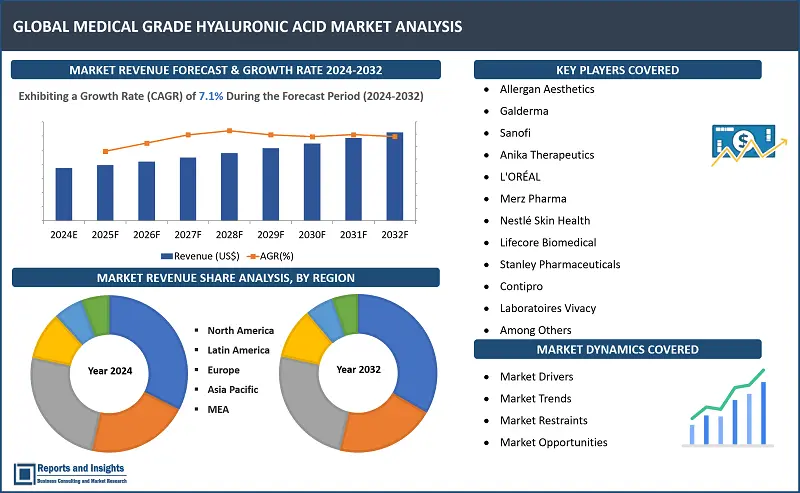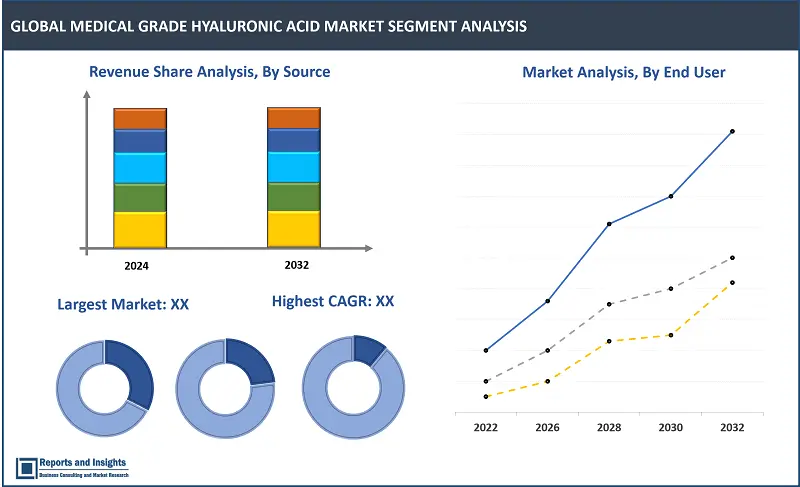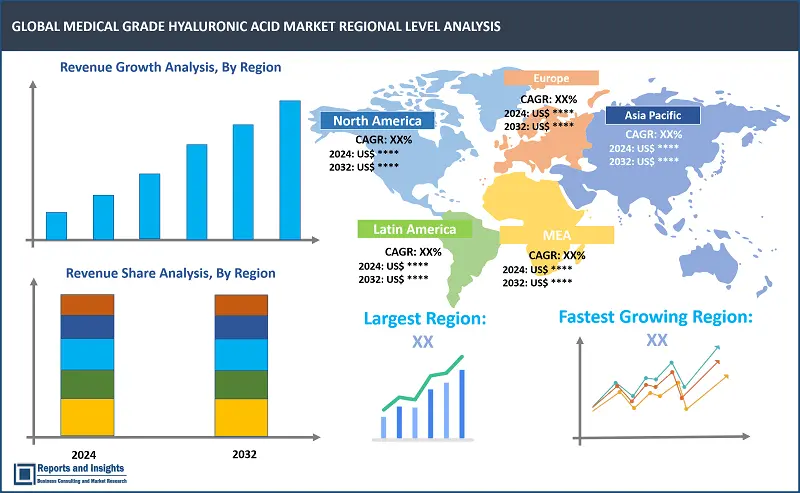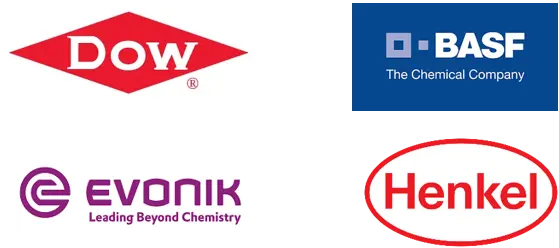Market Overview:
"The medical grade hyaluronic acid market was valued at US$ 1.54 Billion in 2023, and is expected to register a CAGR of 7.1% over the forecast period and reach US$ 2.86 Bn in 2032."
|
Report Attributes |
Details |
|
Base Year |
2023 |
|
Forecast Years |
2024-2032 |
|
Historical Years |
2021-2023 |
|
Medical Grade Hyaluronic Acid Market Growth Rate (2024-2032) |
7.1% |
Medical grade Hyaluronic Acid (HA) is a naturally occurring polysaccharide in the human body, primarily in connective tissues, and helps retain moisture in the skin, eyes, and lubricates the joints, as well as serves as a key component for elasticity due to its remarkable ability to retain moisture. Medical grade HA finds application in a variety of industries including pharmaceuticals, aesthetics, and orthopedics. Medical grade hyaluronic acid is used as a viscosupplement in osteoarthritis treatments, for providing joint lubrication and pain relief, and is also widely used in dermatology for injectable dermal fillers to address wrinkles, and correct face lines and volume loss. It is also used for wound healing and tissue regeneration, and for accelerating the recovery process and reducing scarring.
Medical grade hyaluronic acid manufacturing involves extracting the compound from microbial fermentation or animal sources, followed by purification adhering to stringent processes to ensure safety and efficacy. Recent trends in the market include the adoption of plant-based and synthetic HA for ethical and safety reasons, and advancements in nanotechnology have facilitated development of novel HA delivery systems such as nanoparticles for targeted delivery in therapeutic applications. Demand for medical grade hyaluronic acid has also been increasing due to the biocompatibility, biodegradability, and minimal side effects of this compound in various applications. These advancements have also been positioning HA as an attractive option for developing advanced drug delivery systems, cosmetic treatments, and in regenerative medicine, and HA-based therapies and products.

Medical Grade Hyaluronic Acid Market Trends and Drivers:
The global aging population is expanding rapidly leading to the rising prevalence of various age-related diseases and medical conditions, and this is also driving increased demand for aesthetic and dermatological treatments such as dermal fillers and wrinkle-reducing injections. Also, the number of osteoarthritis cases has been increasing significantly, thereby resulting in increasing use of HA as a viscosupplement for joint lubrication and pain relief, especially in developed countries.
Also, technological advancements in HA extraction and purification techniques have been resulting in higher-yield products with enhanced safety and efficacy, and this along with development of more innovative delivery systems, such as HA-based nanoparticles is enabling expansion of HA therapeutic applications beyond traditional uses. Regulatory support in the form of healthcare policies and guidelines is also having a positive impact on market growth, and is serving to encourage adoption of various medical treatments and procedures; for instance: initiatives to improve wound healing and tissue regeneration have highlighted potential of HA in acceleration of wound recovery and reduced scarring.
In addition, consumer preferences are shifting towards more minimally-invasive cosmetic procedures, and HA-based treatments in the aesthetics industry have been gaining increasing visibility, and awareness regarding the benefits has been rising. An increasing number of skincare, haircare, and personal care product manufacturers are using HA as a key ingredient due to the versatility and biocompatibility properties, and this trend is expected to gain traction over the forecast period.
Medical Grade Hyaluronic Acid Market Restraining Factors:
A primary factor having a negative impact on market growth is high cost of enteral feeding devices, which can deter wider adoption among healthcare providers and patients. Initial expenses for purchasing devices and ongoing maintenance costs can be high, and this makes the option less accessible for individuals and healthcare facilities with budget constraints. Also, reimbursement policies may not fully cover these expenses in some countries, and this also acts as a restraint to adoption.
Safety risks and complications is another factor that can impact sales and preferences to a major extent. Enteral feeding can pose risks such as aspiration pneumonia, tube displacement, or infections if not properly managed, and such safety concerns may deter healthcare providers and patients from choosing enteral feeding devices, especially in situations where alternative nutrition options exist.
In addition, stringent regulatory requirements for the approval and use of enteral feeding devices can pose challenges for manufacturers and healthcare providers, and navigating complex regulatory processes can delay product launches and increase costs. Research and development challenges is a factor that is proving to be crucial to overcome, and developing advanced enteral feeding devices requires substantial investment in R&D. These challenges are further expanded by need to design devices that are easier to use, safer, and more effective across a range of patient types and medical conditions. The high cost of R&D, coupled with the time-consuming process of bringing new devices to market, may slow down the introduction of innovative products, and this can have a negative impact on potential market growth. Also, emerging technologies such as parenteral nutrition, which can offer alternative solutions for patients requiring nutritional support may divert demand away from enteral feeding devices and impact market growth to some extent.
Furthermore, while enteral feeding is a life-saving intervention for many patients, it is not without drawbacks, and potential disadvantages include the physical discomfort and psychological impact of having a feeding tube, which may lead to reduced patient compliance. Additionally, long-term use of feeding devices can cause issues such as mucosal irritation or dependency on the device, affecting patient well-being.
Medical Grade Hyaluronic Acid Market Opportunities:
Leading companies can diversify their product portfolios by developing and offering innovative HA formulations for specific applications, such as combination treatments with other active ingredients for enhanced efficacy in aesthetics or joint health, among others. Tapping into the rapidly growing personalized medicine segment and creating customized HA-based treatments tailored to individual patient needs, particularly in dermatology and orthopedics, will also serve to expand opportunities and revenue streams.
Expansion into emerging markets is another strategy to leverage growth opportunities owing to rising healthcare spending and increasing demand for minimally invasive treatments among a steadily expanding patient pool in developing economies. Strategic partnerships and acquisitions can also enable companies establish a stronger foothold in such markets, while investing in Research and Development (R&D) to explore new applications of HA, such as drug delivery systems and tissue engineering, can result in the creation of groundbreaking products and further establish brand image.
Medical Grade Hyaluronic Acid Market Segmentation:

By Application
- Aesthetic Treatments
- Orthopedics
- Ophthalmology
- Wound Care
Among the application segments, the aesthetic treatments application segment is expected to account for the largest revenue share in the medical grade hyaluronic acid market over the forecast period. Rising demand for minimally invasive cosmetic procedures, such as dermal fillers for wrinkle reduction and facial rejuvenation is a key factor expected to continue to drive revenue growth of this segment. HA's safety and efficacy in enhancing skin volume and smoothness make it a popular choice among consumers seeking anti-aging treatments.
By Form
- Injectable
- Topical
- Oral
- Ophthalmic
Among the form segments, the injectable segment is expected to account for the largest revenue share, and this can be attributed to rising demand for minimally invasive cosmetic treatments, such as dermal fillers, and medical applications in orthopedics, where HA is used for joint lubrication and pain relief. Ongoing innovation in product formulations that enhance efficacy and safety and increasing awareness regarding the benefits of HA in these treatments is expected to support rising growing adoption in healthcare and aesthetics.
By Source
- Animal-based
- Microbial fermentation
- Plant-based
Among the source segments, the microbial fermentation segment is expected to account for the largest revenue share owing to rising demand for this type due to the ability using this method to produce high-quality, consistent, and pure HA without the risk of animal-derived contaminants. Microbial fermentation allows for sustainable production, aligning with the industry shift towards eco-friendly and ethical sourcing. This method also offers the flexibility to meet varying demands, contributing to its wider adoption in various applications such as aesthetics, orthopedics, and ophthalmology.
By End-User
- Hospitals and Clinics
- Dermatology and Aesthetics Clinics
- Homecare
- Pharmacies
Among the end user segments, the hospitals and clinics segment is expected to account for the largest revenue share over the forecast period. This projection is supported by the role hospitals and clinics play as the primary setting for administering HA-based treatments, particularly in aesthetics, orthopedics, and ophthalmology. The availability of skilled healthcare professionals and advanced medical infrastructure facilitates the adoption of HA treatments in these facilities, and also, increasing preference for minimally invasive procedures performed in hospitals and clinics drives the demand for HA-based products.
By Region

North America
- United States
- Canada
Europe
- Germany
- United Kingdom
- France
- Italy
- Spain
- Russia
- Poland
- Benelux
- Nordic
- Rest of Europe
Asia Pacific
- China
- Japan
- India
- South Korea
- ASEAN
- Australia & New Zealand
- Rest of Asia Pacific
Latin America
- Brazil
- Mexico
- Argentina
Middle East & Africa
- Saudi Arabia
- South Africa
- United Arab Emirates
- Israel
- Rest of MEA
The global medical grade Hyaluronic Acid Market is divided into five key regions: North America, Europe, Asia Pacific, Latin America, and the Middle East and Africa. North America leads as the dominant regional market, primarily driven by high healthcare expenditure and a strong demand for aesthetic and orthopedic treatments, especially in the United States (US). In Europe, countries such as Germany, France, and the United Kingdom (UK) are at the forefront, benefiting from a mature healthcare system and a growing interest in minimally invasive cosmetic procedures. Asia Pacific is registering significant growth, with China and Japan emerging as key markets for medical grade HA owing to rapidly aging populations, increased healthcare spending, and greater awareness of HA-based treatments.
Leading Companies in Medical Grade Hyaluronic Acid Market & Competitive Landscape:
The competitive landscape in the global medical grade Hyaluronic Acid Market is marked by intense rivalry among established pharmaceutical and biotechnology companies, as well as emerging players specializing in HA products. Leading companies focus on innovation and product differentiation, investing in research and development to improve HA formulations for efficacy and safety across various applications.
To maintain their position and expand their consumer base, companies are forming strategic partnerships and collaborations with research institutions, healthcare providers, and other industry players. These alliances facilitate the development of new products and the expansion of market reach.
Market leaders are also diversifying their product portfolios to cater to different consumer needs and emerging trends, such as vegan and sustainable sources of HA. Additionally, companies are investing in advanced manufacturing processes to ensure high-quality production and compliance with regulatory standards.
These companies include:
- Allergan Aesthetics
- Galderma
- Sanofi
- Anika Therapeutics
- L'ORÉAL
- Merz Pharma
- Nestlé Skin Health
- Lifecore Biomedical
- Stanley Pharmaceuticals
- Contipro
- Laboratoires Vivacy
- Fidia Farmaceutici S.P.A.
- BioScience GmbH
- Hyaltech
- Shiseido
Recent Developments:
- January 2024: Galderma, which is a leading company in the dermatology field, announced receiving approval from Health Canada for its Restylane SHAYPE, which is a Hyaluronic Acid (HA) injectable product intended for the temporary augmentation of the chin area. The product is designed for deep injection to achieve a bone-like effect, enhancing chin shape and definition.
- January 2024: L'Oréal Paris Launched New Elvive Hyaluron + Pure Collection following the successful launch of the 2023 L'Oréal Paris Elvive Hyaluron + Plump line, which debuted exclusively at Walmart in the fall of 2022. The brand has partnered with the retailer once more to offer another exclusive collection: Hyaluron + Pure. This new line includes a Shampoo, Conditioner, and Oil Erasing Scalp Serum. L'Oréal Paris Elvive expanded into the hydration market with the launch of the Hyaluron + Plump line, emphasizing science-driven formulations that contain Hyaluronic Acid. Now, Elvive Hyaluron + Pure builds on L'Oréal Paris's recognized expertise in this ingredient with a fresh collection. The new line features products containing Hyaluronic and Salicylic Acids, which exfoliate and cleanse the scalp while eliminating up to 100% of dulling residue and hydrating hair ends.
- May 2023: Allergan Aesthetics, which is an AbbVie company, announced securing U.S. FDA approval for SKINVIVE by JUVÉDERM. SKINVIVE is a Hyaluronic Acid (HA) gel microdroplet injectable designed for facial use, targeting the reduction of lines and wrinkles, boosting hydration, and enhancing skin quality and is for use in adults aged 21 and older. Additionally, it includes 0.3% lidocaine to help minimize discomfort during the injection process.
Medical Grade Hyaluronic Acid Market Research Scope
|
Report Metric |
Report Details |
|
Medical Grade Hyaluronic Acid Market Size available for the Years |
2021-2023 |
|
Base Year |
2023 |
|
Forecast Period |
2024-2032 |
|
Compound Annual Growth Rate (CAGR) |
7.1% |
|
Segment covered |
Application, Form, Source, End-user, and Region |
|
Regions Covered |
North America: The U.S. & Canada Latin America: Brazil, Mexico, Argentina, & Rest of Latin America Asia Pacific: China, India, Japan, Australia & New Zealand, ASEAN, & Rest of Asia Pacific Europe: Germany, The U.K., France, Spain, Italy, Russia, Poland, BENELUX, NORDIC, & Rest of Europe The Middle East & Africa: Saudi Arabia, United Arab Emirates, South Africa, Egypt, Israel, and Rest of MEA |
|
Fastest Growing Country in Europe |
Germany |
|
Largest Market |
North America |
|
Key Players |
Allergan Aesthetics, Galderma, Sanofi, Anika Therapeutics, L'ORÉAL, Merz Pharma, Nestlé Skin Health, Lifecore Biomedical, Stanley Pharmaceuticals, Contipro, Laboratoires Vivacy, Fidia Farmaceutici, BioScience GmbH, Hyaltech, Shiseido |
Frequently Asked Question
What is the size of the global medical grade hyaluronic acid market in 2023?
The global medical grade hyaluronic acid market size reached US$ 1.54 Billion in 2023.
At what CAGR will the global medical grade hyaluronic acid market expand?
The global market is expected to register a 7.1% CAGR through 2024-2032.
Who are leaders in the medical grade hyaluronic acid market?
Allergan Aesthetics, Galderma, and Sanofi leverage their robust research and development capabilities, product portfolios, and market presence to maintain leading positions in the market.
What are some key factors driving revenue growth of the medical grade hyaluronic acid market?
Rising demand for minimally invasive aesthetic treatments, such as dermal fillers, and increasing prevalence of osteoarthritis, which necessitates joint health solutions.
What are some major challenges faced by companies in the medical grade hyaluronic acid market?
Companies in the medical grade HA market face challenges such as maintaining high standards of product quality and safety, complying with stringent regulatory requirements, and staying ahead in a competitive market.
How is the competitive landscape in the medical grade hyaluronic acid market?
The competitive landscape in the medical grade HA market is characterized by the presence of both established and emerging players, each striving to innovate and expand their market share.
How is the medical grade hyaluronic acid market report segmented?
The medical grade hyaluronic acid market report is segmented based on form, source, end-user, and region.
Who are the key players in the medical grade hyaluronic acid market report?
Allergan Aesthetics, Galderma, Sanofi, Anika Therapeutics, L'ORÉAL, Merz Pharma, Nestlé Skin Health, Lifecore Biomedical, Stanley Pharmaceuticals, Contipro, Laboratoires Vivacy, Fidia Farmaceutici, BioScience GmbH, Hyaltech, Shiseido.

